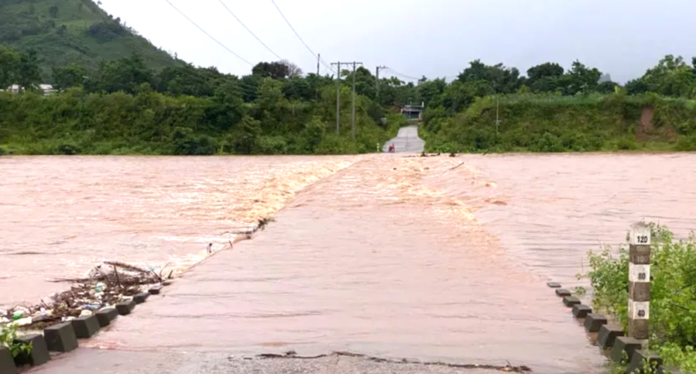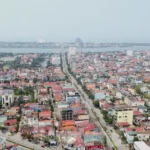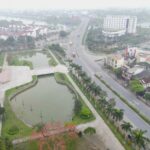In Quang Tri, according to the Office of the Provincial Steering Committee for Natural Disaster Prevention, Search and Rescue, more than 1,046 hectares of summer-autumn rice were submerged, mainly in Hai Lang district with 1,026 hectares, and the rest in Cam Lo district. In addition, 14 hectares of lotus and 12.5 hectares of vegetables in Hai Lang district were also underwater. This is considered the first severe flood of this summer-autumn crop in the locality.
In the mountainous area of the province, the rising floodwaters from the rivers and streams have cut off many roads. The La Lay International Border Gate Border Post said that the water level had overflowed the spillways by 0.5 to 1 meter. The border guards have set up checkpoints and tightly controlled the area to prevent people from traveling through dangerous points.

Meanwhile, in Hue city, the rainfall recorded in the morning of June 12 was the highest in the country. At Bach Ma peak (Phu Loc district), the rainfall reached more than 563mm; Khe Mo Rang station recorded more than 519mm, and Bach Ma National Park recorded more than 434mm.
The prolonged heavy rain caused localized flooding in many inner-city areas, causing serious landslides on the road leading to the La Son – Tuy Loan expressway (in Huong Phu commune, Phu Loc district), forcing authorities to temporarily ban traffic until repairs could be made.
Notably, according to the Office of the City Steering Committee for Natural Disaster Prevention, Search and Rescue, some places recorded rainfall exceeding 100mm within 3 hours. From now until June 13, the area is expected to continue to experience heavy to very heavy rainfall, with a total rainfall of 70-200mm, and some places even exceeding 300mm.
Localities such as Huong Tra, Huong Thuy, Phu Vang, and Phu Loc have proactively deployed response plans for prolonged heavy rainfall. Irrigation pumping stations, as well as intra-field canals, have also been inspected and operated to protect the summer-autumn crop area.

According to the Hue City Hydro-Meteorological Station, this is an unusual rainfall event in the middle of summer, with an intensity and amount of rain rarely seen in recent years. Water levels in large reservoirs and hydropower plants, such as Ta Trach, Huong Dien, and Binh Dien, are currently safe and are being closely monitored.
Given the complex developments of Typhoon No. 1, the leaders of Quang Tri and Hue City have urgently directed the departments, branches, and local authorities to deploy response measures following the principle of “four on-site.” The focus is on monitoring the developments of the floods, being ready to evacuate people from dangerous areas, and ensuring the safety of life and property.
Functional forces are arranged at submerged bridges, weak bridges, and deep-flooded areas to control people and vehicles, not allowing travel if safety cannot be guaranteed. Reservoir, dike, and drainage works are inspected and reinforced to prevent risks. In coastal areas, the work of calling for boats to find shelter from the typhoon was completed by the afternoon of June 11.
The Department of Agriculture and Environment is assigned to monitor natural disasters, direct the assurance of agricultural and aquatic production safety, guide drainage and protection of summer-autumn crop areas in low-lying areas. The Department of Construction inspects transport infrastructure and is ready to repair landslides and subsidence. The Department of Industry and Trade controls the safety of small and large hydropower plants.
The two provincial Hydro-Meteorological Stations have strengthened disaster forecasting and warning information, and the local press agencies have coordinated to continuously update information on the situation of floods, the path, and intensity of the typhoon so that people can proactively prevent and avoid them.
The Provincial Border Guard Command directs coastal units to coordinate closely with the Maritime Office, the Fisheries Branch, and the Coastal Information Station to guide ships to find shelter, ensuring absolute safety of people and vehicles.
The Office of the Provincial Steering Committee for Natural Disaster Prevention, Search and Rescue of the two localities is requested to maintain 24-hour duty, closely monitor the situation, and promptly advise the provincial leaders in directing and responding to the typhoon.
The Storm Doesn’t Make Landfall but Brings Heavy Rain
“The latest update on Tropical Storm Wutip (as named in English), which is the first storm to hit the region this year, indicates that it is not expected to make landfall. However, it will bring heavy rainfall to Central Vietnam, the Central Highlands, and the neighboring areas. The expected rainfall in these regions is estimated to range from 100 to 200mm, with some localities potentially receiving up to 300mm or even exceeding 350mm.”
“Over 1,200 Officials in Quang Tri Province Seek Housing in Quang Binh: A Challenge for Authorities”
Let me know if there are any other adjustments or refinements you’d like to make to this title to ensure it aligns with your goals and captures the essence of the topic.
The upcoming merger of Quang Tri Province and Dong Hoi City in Quang Binh Province has brought to light the housing needs of approximately 1,194 officials. These individuals will be relocating to the city and require suitable accommodations to continue their important work in the region.
Launching a New Bus Route: Connecting Quang Tri and Quang Binh, Serving Passengers with Seamless Provincial Travel
The provinces of Quang Tri and Quang Binh are working diligently to finalize procedures and launch a fixed-route and inter-provincial bus service, catering to the transportation needs of passengers post-merger.





















